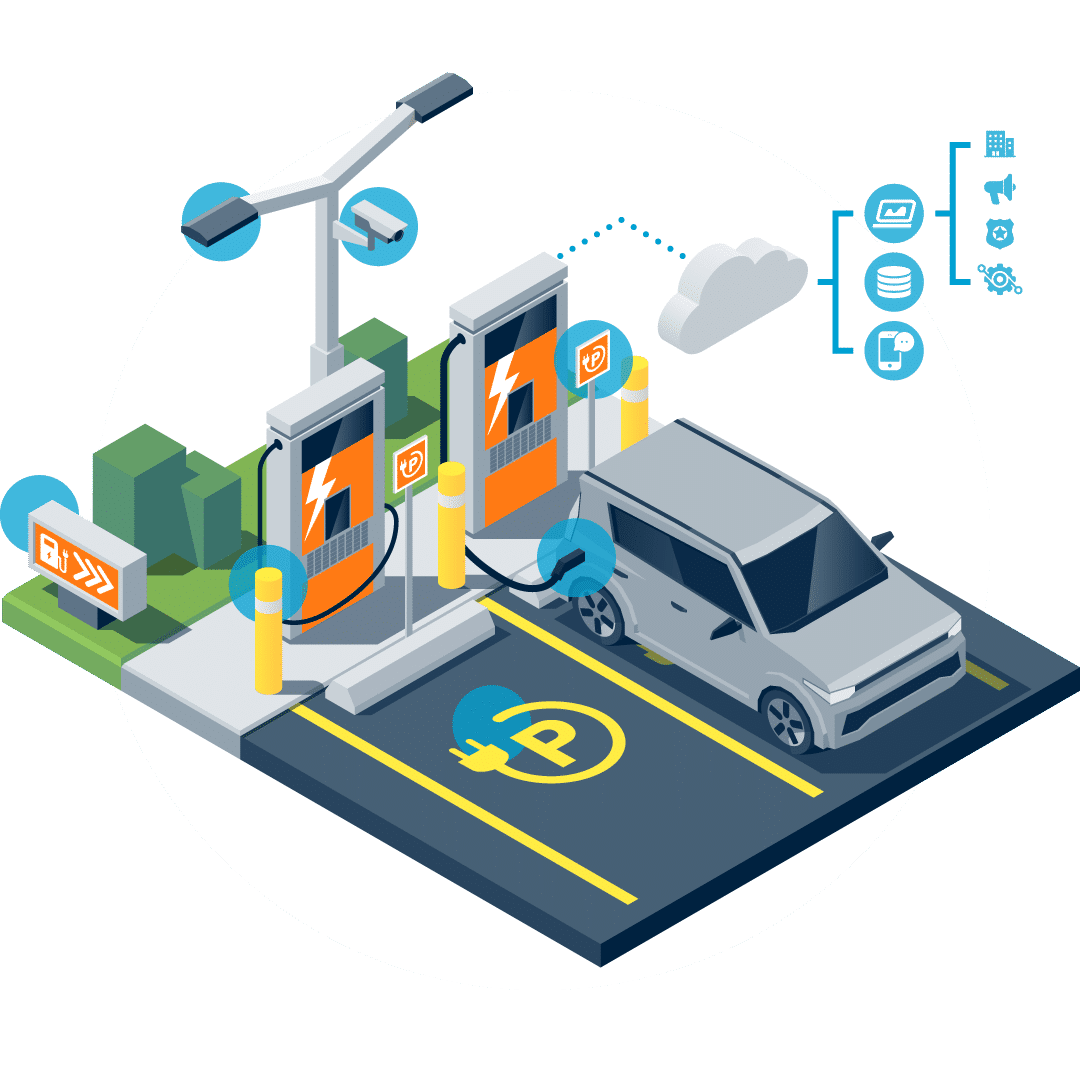EV Charger Power Management for Auto Dealerships
It should come as no surprise that rising consumer interest in electric vehicles (EVs) will have a profound effect on power consumption. Any comprehensive EV charging solution must address this consideration. In fact, a study by the US Department of Energy found that electricity use could increase up to 38% by 2050, in large part due to EVs.
That same study found that the average EV uses about 30 kilowatt-hours (kWh) to travel 100 miles. This is about the same amount of electricity that runs an average American household every day.
At a minimum, electric vehicle chargers will double the electricity required to operate your dealership, according to estimates by Future Energy. Does your property have the utility power access to accommodate this increase in use? Like most dealerships, your business may not be capable of handling this additional power load with your current setup.
Moreover, your dealership needs to develop strategies for avoiding unexpected charges and controlling operating costs. EV charger power management for auto dealerships is a critical part of managing your transition to electric vehicles.


Managing Your Electric Load
Your local utility determines the rate you pay for electricity for the year according to your peak demand. Peak demand means the maximum amount of electricity you use in a set time period, generally 15 minutes. If you exceed peak demand for even a few minutes, your rate might increase. The utility can reestablish how much you pay according to your new peak.
That’s why it is critical to carefully monitor your electric load to avoid costly mistakes for your dealership.
Time-of-Day Rates
Your dealership can benefit from a thorough understanding of how the time at which your customers’ vehicles or your inventory is charged can affect your bottom line.
For example, the city of Seattle unveiled an Electrification Strategic Investment Plan, which involves public installation of EV chargers. Seattle’s electric utility, Seattle City Light, uses a time-of-day fee structure. For public EV fast chargers, drivers pay 32 cents per kWh to charge during the day, which is a peak time. By contrast, charging at night reduces the cost to just 17 cents per kWh. Many other utilities across the country have similar programs.
Smart Charging Programs
Most utility companies will require you to network your electric vehicle chargers with them. This is known as smart charging, a cloud-based technology that became widely used in Europe starting in 2017. Smart charging allows the utility company—as well as your business—to monitor how much energy your EV charging stations are using. A smart charging solution such as Maestro™ helps you network not only with your local utility but also with all the systems on your property. From any screen on any device in real time, Maestro monitors your lighting, security, and other intelligent systems. Maestro helps keep you informed when your dealership’s power usage rises or falls during peak demand.
Load Management
Networked EV chargers can communicate with each other, which helps your dealership with local load management. Load management allows you to use your business’ electrical system to support multiple EV chargers at once. In effect, networked chargers balance the energy flow so that the electrical system doesn’t overload and delivers the correct amount of power to each EV charging unit. A monitoring system such as Maestro also can configure the maximum aggregate load for your EV chargers to help manage power output. That way, your dealership will not exceed peak load and incur unexpected expenses in your electric bill.
Data Analysis
Plus, because Maestro networks seamlessly, it can regularly update itself. It can adapt to your dealership’s changing needs over time. In the bigger picture, data analytics from EV chargers can help reveal travel patterns, according to Streetlight Data. This, in turn, will help identify where there is a need for new electric vehicle chargers. Furthermore, data from EV chargers can help utilities analyze the power grid, creating greater efficiencies in the broader electrical infrastructure.

Building Your EV Charging Solution
Networked EV chargers do more than just plug and charge. The creation of the EV charging environment begins well before installation.
Site Analysis
Future Energy program managers discuss EV charger power management for auto dealerships with you. They come to your dealership and walk you through the entire process, including utility company expectations. Will you need to ask the utility company to bring in additional service? Is your electrical panel sufficient to handle the increased load of EV chargers on premises? Additionally, publicly available electric car charging stations can spark interest in first-time buyers. If a driver sees EV charging stations while passing by the dealership, they will know that infrastructure is available to support their new vehicle. As a result, the driver may visit the car dealership to purchase their first EV.
Infrastructure Planning
An electrical contractor can put together a one-line drawing, which is a symbolic representation of your power system. In many cases, your local utility will require your dealership to submit this drawing. The utility then can see how you plan to wire your location as you consider EV chargers for sale.
Power Management Strategies
As you make the move toward EVs, your dealership will need to obtain adequate power accommodations for your property as well as for your out-lot locations. At Future Energy, we work with your utility company to create strategies to help you. Then, Maestro helps you visualize and manage your power consumption. Your dealership can be proactive with its power management, using Maestro’s alerts to help you avoid peak demand charges. An alert from Maestro may indicate you need to shift electrical usage to non-peak times. Or your business could switch to a standby generator to alleviate power use during a critical time. Either way, using the data analytics and monitoring capabilities of Maestro helps your dealership to optimize electricity costs. If you have a number of EV charging stations, you can develop custom reports regarding your energy use. Future Energy can help your dealership master the Maestro software to create and monitor your own key performance indicators.

Finding Incentives with Future Energy
If you know where to look, your dealership can find numerous incentives and grants to help offset the cost of installing EV chargers. Future Energy works with your dealership to uncover whatever funding is available.
Utility Assessment
At Future Energy, our ChargeParc™ EV charging solution involves more than just planning and installation. We scour the landscape to find any money that helps your dealership cover your costs. Available incentives for your dealership depend upon your city, state, and utility company and we are experts at finding and obtaining available incentives.
Incentive Documents
Once Future Energy helps you identify potential funding sources, we then help you file the necessary documents with your local or state government or utility. Many rebate programs have monetary caps, so it’s important to act quickly to file the paperwork to reserve your project and the accompanying funds.

Electric Charging Stations Promote Healthy Customer Relationships
In addition to driving sales and increasing brand awareness, investing in electric car charging stations can help a dealership foster healthy customer relationships. Commercial EV chargers not only help attract potential and existing customers—they also signal to potential buyers that a dealership shares their rapidly expanding values for sustainability.
Developing Electric Vehicle Charging Station Infrastructure
NREL reports that as of 2020, there were 105 EV charging stations per 100,000 people in the United States. By installing EV charger infrastructure, commercial dealerships can do their part to expand this infrastructure and increase the EV market. With greater infrastructure availability, more drivers will be willing to purchase these sustainable vehicles.
Future Servicing Opportunities
If a current EV owner sees that a dealership has an electric vehicle charging station, they know that the company supports EVs overall. They might see the dealership as an ideal place to bring their EVs for servicing. Additionally, if a dealership increases EV sales by offering electric charging stations, it can extend the customer relationship by encouraging new owners to visit the property for maintenance.
Commitment to Sustainability
Research from IBM shows that six in ten consumers are willing to change their purchasing habits to reduce their impact on the environment. Additionally, 77% of consumers cite sustainability as a key value when buying a product.
By installing commercial EV chargers, a dealership signals to customers and passersby that it is committed to sustainability. Customized branding also makes it more likely that a driver will associate a dealership with a culture of environmental responsibility.
Supporting Your Dealership’s Move Toward EV Charging
Future Energy provides a full complement of support for your dealership’s venture into electric vehicle infrastructure. Contact us today to find out how our comprehensive ChargeParc solution uses data to drive EV charger power management for auto dealerships.

Included with Future Energy’s EV dealership solution


Future Energy’s complete, EV vehicle charging solution delivered as a turn-key environment.


Future Energy’s data visualization and management dashboard that connects all intelligent building systems.


Future Energy’s intelligent building systems solution that integrates your property’s lighting, climate, safety monitoring and more.
Rebates & Financial Incentives
Growing into the world of electric vehicles has never been more affordable or easier. Incentive programs include an array of combinable credits that can potentially cover all of the cost of your EV charging installation. Contact us to find out what funding is available to you.